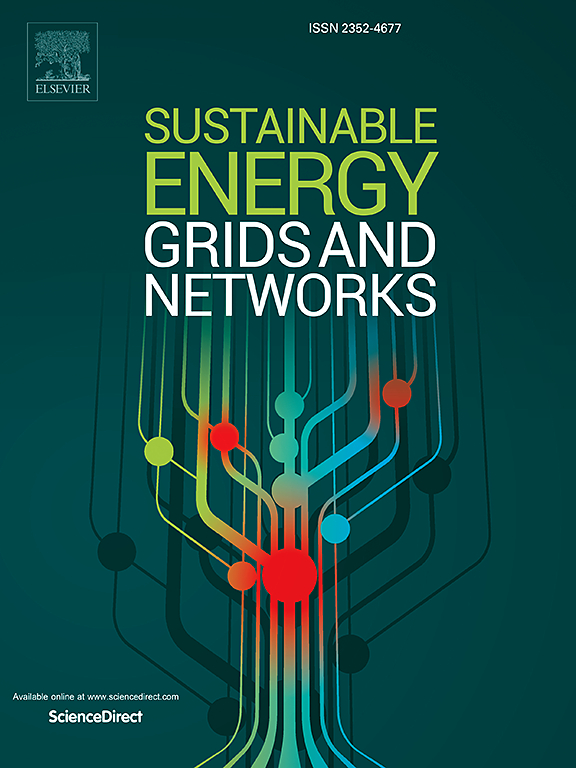具有压缩空气储能和需求响应的可再生能源多微电网最优安全约束调度
IF 5.6
2区 工程技术
Q2 ENERGY & FUELS
引用次数: 0
摘要
多微电网的运行面临随机故障以及可再生能源和负荷的高不确定性。随机方法包含风速、电价、太阳辐照和负荷需求等多种不确定性。此外,通过选择具有代表性的场景子集,采用场景约简方法来降低随机优化的计算复杂度。CAES为管理输电拥塞和可再生能源消费提供了一种灵活的解决方案。由于可再生能源的广泛使用,压缩空气储能系统(CAES)集成和安全约束单元承诺(SCUC)的多mg运行在这些网络中变得越来越重要。本文提出了一种随机scc多mg调度模型,以协调CAES与需求响应(DR)计划,在保证不确定情景下系统灵活性的同时保持运行成本效益。DR程序可能会使负荷曲线变平,并将能源使用从高峰时间转移到非高峰时间。这种整合旨在降低总成本,最大限度地减少可再生能源的弃电,并提高电压分布和稳定性。该模型采用混合整数二次约束规划(MIQCP)方法和Bender分解技术,以最小的计算时间获得全局最优解。通过在IEEE 30总线和IEEE 118总线系统上实施的各种案例研究,检验了所提出模型的好处。研究结果表明,与基本情况相比,考虑可再生能源和CAESs,总成本降低了6.981 %,电压稳定性提高了5.32 %,电压偏差降低了30.22 %。本文章由计算机程序翻译,如有差异,请以英文原文为准。
Optimal security-constrained scheduling of a renewable energy-based multi-microgrid with compressed air energy storage and demand response
The operation of a multi-microgrid (MG) is exposed to random failures as well as high uncertainties from renewable energy sources (RESs) and load. The stochastic method encompasses multiple uncertainties, including wind speed, electricity price, solar irradiation, and load demand. Moreover, a scenario reduction approach is employed to mitigate computational complexity in stochastic optimization by selecting a representative subset of scenarios. CAES presents a flexible solution for managing transmission congestion and consuming renewable energy. Compressed air energy storage system (CAES) integration and multi-MG operation of security-constrained unit commitment (SCUC) are becoming increasingly important in these networks due to the extensive use of renewable energy. This paper proposes a stochastic SCUC multi-MG dispatch model to coordinate CAES with a demand response (DR) program, ensuring system flexibility under uncertain scenarios while maintaining operational cost-effectiveness. The DR program might flatten the load curve and move energy use from peak to off-peak hours. This integration aims to reduce total costs, minimize renewable curtailment, and enhance voltage profile and stability. The model employs a mixed-integer quadratically constrained programming (MIQCP) approach and a Bender decomposition technique to achieve a global optimum solution with minimal computational time. The benefits of the proposed model are examined through various case studies implemented on the IEEE 30-bus and IEEE 118-bus systems. The findings show that the total cost is reduced by 6.981 %, voltage stability improves by 5.32 %, and voltage deviations decrease by 30.22 % in the presence of renewable power and CAESs, considering the DR program compared to the base case.
求助全文
通过发布文献求助,成功后即可免费获取论文全文。
去求助
来源期刊

Sustainable Energy Grids & Networks
Energy-Energy Engineering and Power Technology
CiteScore
7.90
自引率
13.00%
发文量
206
审稿时长
49 days
期刊介绍:
Sustainable Energy, Grids and Networks (SEGAN)is an international peer-reviewed publication for theoretical and applied research dealing with energy, information grids and power networks, including smart grids from super to micro grid scales. SEGAN welcomes papers describing fundamental advances in mathematical, statistical or computational methods with application to power and energy systems, as well as papers on applications, computation and modeling in the areas of electrical and energy systems with coupled information and communication technologies.
 求助内容:
求助内容: 应助结果提醒方式:
应助结果提醒方式:


